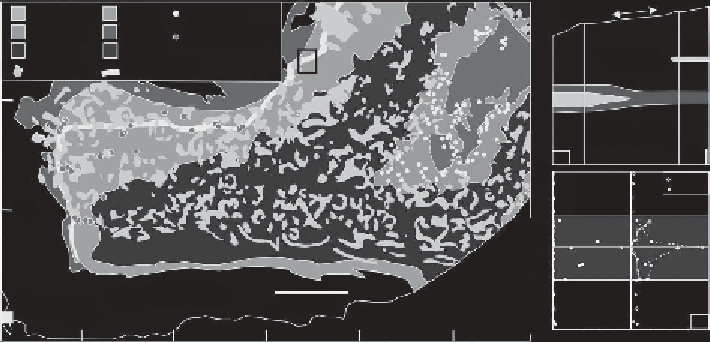Environmental Engineering Reference
In-Depth Information
DP1/78
112.1m
KL1/78
139.6m
3 km
Drakensberg Gr.
Ecca Gr.
Hydrothermal
vent complex
Breccia pipes (cluster)
Stormberg Gr.
Beaufort Gr.
Sill intrusion
Dwyka Gr.
Basement
The Whitehill Fm.
Sill
Tieberg Fm.
30
Whitehill Fm.
Sill
Prince Albert Fm.
15m
KL1/78
DP1/78
b
60
32
70
Cape Foldbelt
80
Cape Town
150 km
Indian Ocean
c
20
24
28
0
5 10 15 20
51015
a
S2 (mg/g)
TOC (wt. %)
Figure 12.4 (a) Geological map of the Karoo Basin in South Africa. Two
different types of degassing structures are present in the basin: breccia pipes in
the organic-rich shales in the west, and hydrothermal vent complexes in the upper,
sand-dominated levels in the basin. (b) Cross section showing a 15-m-thick sill
emplaced in organic-rich shale and two boreholes studied for contact
metamorphism (Aarnes
et al
.,
2011
). (c) Data from the contact aureole and the
unaffected background shale. Note the destruction of the pyrolysis hydrocarbon
productivity (the S2 parameter) in the aureole and the lowering of the total
organic carbon (TOC) content from about 15 wt.% to zero at the contact with
the sill. A black and white version of this
figure will appear in some formats.
For
isotopic record preserved in the breccia pipes and crater deposits re
ect mobilization
and transport of carbon and sulfur from the Tunguska Basin to the end-Permian
environment (Aarnes
et al
.,
2011
).
12.2.2 The Karoo province and the Karoo Basin
The Upper Carboniferous to Jurassic Karoo Supergroup in South Africa has a
maximum cumulative thickness of 12 km and a preserved maximum thickness
of 5.5 km (Tankard
et al
.,
2009
). The current area with outcropping Karoo sedi-
ments in South Africa is about 630,000 km
2
(
Figure 12.4a
), but time-equivalent
sedimentary rocks are present throughout southern Africa. The depositional envir-
onments range from marine to
finally eolian (Catuneanu
et al
.,
1998
).
The Karoo Basin is overlain by 1.6 km of volcanic rocks of the Drakensberg
Group, consisting mainly of stacked basalt
fluvial and
flows erupted in a continental environ-
ment. The plumbing system of the
flood basalts is a basin-scale complex consisting
of sills and dykes (Marsh and Eales,
1984
; Chevallier and Woodford,
1999
).

